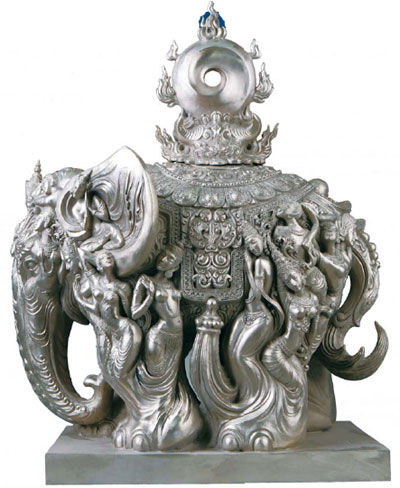
The bronze sculpture Auspicious Elephants is decorated with Buddhist nymphs and motifs.
The creator of the 2008 Beijing Olympic mascots, the Fuwa, Han Meilin is hosting a retrospective of his 60-year career in the biggest solo show of a living artist's works in the National Museum of China's history.
The five-part exhibition presents more than 3,200 works in a nearly 6,000-square-meter exhibition area. The 75-year-old's works cover a variety of media - ink paintings, calligraphic works, sculptures, ceramics and graphic designs.
"The mammoth exhibition is a gift to visitors to welcome the Lunar New Year," museum director Lu Zhangshen says. "It's an art feast for all ages." Highlights include a pair of bronze sculptures entitled Auspicious Elephants, decorated Buddhist nymphs and motifs, a pair of 20-meter-wide steel sculptures featuring a dragon and a phoenix, and a 10-meter-wide hanging scroll of galloping horses. Also on display is the Sealed Book calligraphy series based on his collection of unknown ancient characters, the red Air China logo and his Fuwa manuscripts.
The exhibition reveals only some of Han's creations. He has also created woodcarvings, bronze weapons, paper-cuts, cloth wall hangings and painted cloth tigers.
"The wonderfully varied works of this master artist vividly reflect China's monumental changes over the past 60 years," Chinese Folk Artists Association chairman Feng Jicai says.
The association has long worked with Han to preserve the country's vanishing folk arts.
But Han thinks of it in another way.
"I'm always answering my heart when I create," he says.
Han's friends often say he baffles them.
"He's hard to define," says Bai Yansong, Han's friend and the TV personality who hosted the show's opening ceremony.
"It's amazing how much energy he still has at 75."
Han believes in infusing modern concepts into folk art.
Most of his works are imbued with elements from the classical culture that flourished before the Han Dynasty (206 BC-AD 220) and actively borrow from China's diverse folk arts. He sometimes also absorbs Western elements, explains art critic Chen Lusheng.
"But while he uses Chinese and foreign styles, he focuses on the Chinese," Chen says.
"While he incorporates both ancient and modern essences, the modern triumphs."
Han also emphasizes the creative process more than the subject matter, Chen says.
"The final results visually appeal to viewers."
Han also moves between extremes in size. Some of his pieces are colossal sculptures, while others are tiny ceramic works.
"There wouldn't be such a striking visual effect without the dramatic size contrasts."
Ceramics is his favorite medium.
He injects contemporary imagery in his traditional ceramic works, especially his Jun kiln porcelains and Yixing purple-clay teapots.
All art must have a "root", he says.
He attributes his success to a deep understanding of his roots and his close ties to ordinary people.
Han was born in Shandong's provincial capital Jinan on Dec 26, 1936, and went on to lead a tumultuous life. He graduated as a textile and dye major from the Central Academy of Arts and Design.
He was sent to work at the Huainan Porcelain Factory in Anhui province during the "cultural revolution" (1966-76).
"While it was a time of hardship for me, I gained a solid understanding of porcelain-making techniques and a deep comprehension of Chinese porcelain culture," Han recalls.
He has often traveled with his students and assistants to the countryside over the decades to offer free design assistance and technology upgrades to local art and handicraft studios.
He has also donated supplies to impoverished children and helped build Hope Project primary schools in underdeveloped areas.
"An artist must keep in touch with real life in such a rapidly changing society," Han says.
Han has also created a calligraphic series entitled Sealed Book. It's based on his collection of tens of thousands of characters from inscriptions found on ancient oracle bones, cliff carvings, excavated ceramics and bronze objects. Their pronunciations, meanings and structures are all unknown, Han says.
"But they provide tremendous inspiration for my creations," he says.
Han hopes as many people as possible people can enjoy his art.
He has donated thousands of his works to museums since 2005.
Two galleries bearing his name have opened in Beijing and Zhejiang's provincial capital Hangzhou. Each displays at least 3,000 of Han's donated works.
He has pushed to introduce Chinese art to global audiences since 1980. In 1983, six of his works were elected as the United Nations' Christmas card images.
In 2003 and 2004, the World Artists Association honored him for his "special contribution to world art" and bestowed upon him the World Art Master prize.
Former US president George W. Bush gave him the President's Award for Educational Excellence in 2004.
And a panel of Beijing media editors voted him to the top of the "The Most Globally Concerned Chinese Characters in 2011" list.
His exhausting work and involvement in social affairs have caused several chronic ailments. He underwent critical surgery because of heart disease five years ago and considers himself lucky to have survived.
"Death didn't like my laziness and kicked me out," he says, jokingly.
"He told me I still have another 100 years to live."
Han regards the exhibition as a new beginning for - rather than a summary of - his artistic journey.
"Artistic creation gives meaning to my life," he says.
"I'll never stop working as long as I'm alive."

Copyright ©1999-2011 Chinanews.com. All rights reserved.
Reproduction in whole or in part without permission is prohibited.